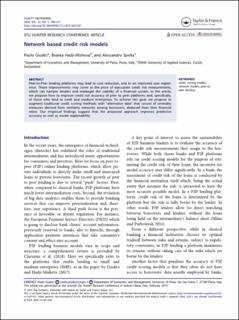Please use this identifier to cite or link to this item:
https://doi.org/10.21256/zhaw-23432Full metadata record
| DC Field | Value | Language |
|---|---|---|
| dc.contributor.author | Giudici, Paolo | - |
| dc.contributor.author | Hadji Misheva, Branka | - |
| dc.contributor.author | Spelta, Alessandro | - |
| dc.date.accessioned | 2021-11-10T08:08:20Z | - |
| dc.date.available | 2021-11-10T08:08:20Z | - |
| dc.date.issued | 2019 | - |
| dc.identifier.issn | 0898-2112 | de_CH |
| dc.identifier.issn | 1532-4222 | de_CH |
| dc.identifier.uri | https://digitalcollection.zhaw.ch/handle/11475/23432 | - |
| dc.description.abstract | Peer-to-Peer lending platforms may lead to cost reduction, and to an improved user experience. These improvements may come at the price of inaccurate credit risk measurements, which can hamper lenders and endanger the stability of a financial system. In the article, we propose how to improve credit risk accuracy of peer to peer platforms and, specifically, of those who lend to small and medium enterprises. To achieve this goal, we propose toaugment traditional credit scoring methods with “alternative data” that consist of centralitymeasures derived from similarity networks among borrowers, deduced from their financialratios. Our empirical findings suggest that the proposed approach improves predictiveaccuracy as well as model explainability. | de_CH |
| dc.language.iso | en | de_CH |
| dc.publisher | Taylor & Francis | de_CH |
| dc.relation.ispartof | Quality Engineering | de_CH |
| dc.rights | https://creativecommons.org/licenses/by-nc-nd/4.0/ | de_CH |
| dc.subject | Credit scoring model | de_CH |
| dc.subject | Network model | de_CH |
| dc.subject | Peer-to-peer lending | de_CH |
| dc.subject.ddc | 332: Finanzwirtschaft | de_CH |
| dc.title | Network based credit risk models | de_CH |
| dc.type | Beitrag in wissenschaftlicher Zeitschrift | de_CH |
| dcterms.type | Text | de_CH |
| zhaw.departement | School of Engineering | de_CH |
| zhaw.organisationalunit | Institut für Datenanalyse und Prozessdesign (IDP) | de_CH |
| dc.identifier.doi | 10.1080/08982112.2019.1655159 | de_CH |
| dc.identifier.doi | 10.21256/zhaw-23432 | - |
| zhaw.funding.eu | No | de_CH |
| zhaw.issue | 2 | de_CH |
| zhaw.originated.zhaw | Yes | de_CH |
| zhaw.pages.end | 211 | de_CH |
| zhaw.pages.start | 199 | de_CH |
| zhaw.publication.status | publishedVersion | de_CH |
| zhaw.volume | 32 | de_CH |
| zhaw.publication.review | Peer review (Publikation) | de_CH |
| zhaw.webfeed | FinTech | de_CH |
| zhaw.author.additional | No | de_CH |
| zhaw.display.portrait | Yes | de_CH |
| Appears in collections: | Publikationen School of Engineering | |
Files in This Item:
| File | Description | Size | Format | |
|---|---|---|---|---|
| 2019_Giudici-etal_Network-based-credit-risk-models.pdf | 2.53 MB | Adobe PDF |  View/Open |
Show simple item record
Giudici, P., Hadji Misheva, B., & Spelta, A. (2019). Network based credit risk models. Quality Engineering, 32(2), 199–211. https://doi.org/10.1080/08982112.2019.1655159
Giudici, P., Hadji Misheva, B. and Spelta, A. (2019) ‘Network based credit risk models’, Quality Engineering, 32(2), pp. 199–211. Available at: https://doi.org/10.1080/08982112.2019.1655159.
P. Giudici, B. Hadji Misheva, and A. Spelta, “Network based credit risk models,” Quality Engineering, vol. 32, no. 2, pp. 199–211, 2019, doi: 10.1080/08982112.2019.1655159.
GIUDICI, Paolo, Branka HADJI MISHEVA und Alessandro SPELTA, 2019. Network based credit risk models. Quality Engineering. 2019. Bd. 32, Nr. 2, S. 199–211. DOI 10.1080/08982112.2019.1655159
Giudici, Paolo, Branka Hadji Misheva, and Alessandro Spelta. 2019. “Network Based Credit Risk Models.” Quality Engineering 32 (2): 199–211. https://doi.org/10.1080/08982112.2019.1655159.
Giudici, Paolo, et al. “Network Based Credit Risk Models.” Quality Engineering, vol. 32, no. 2, 2019, pp. 199–211, https://doi.org/10.1080/08982112.2019.1655159.
Items in DSpace are protected by copyright, with all rights reserved, unless otherwise indicated.